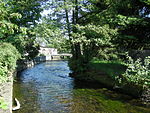Graffenstaden station
Pages with no open date in Infobox stationRailway stations in Bas-Rhin

Graffenstaden station (French: Gare de Graffenstaden) is a railway station serving the industrial zone of Geispolsheim, close to the commune of Illkirch-Graffenstaden, Bas-Rhin department, France. The station is owned and operated by SNCF, in the TER Grand Est regional rail network and is served by TER trains.
Excerpt from the Wikipedia article Graffenstaden station (License: CC BY-SA 3.0, Authors, Images).Graffenstaden station
Rue de l'Industrie, Strasbourg
Geographical coordinates (GPS) Address Nearby Places Show on map
Geographical coordinates (GPS)
| Latitude | Longitude |
|---|---|
| N 48.5323 ° | E 7.6897 ° |
Address
Graffenstaden
Rue de l'Industrie
67118 Strasbourg
Grand Est, France
Open on Google Maps








